- Home
- Laurie R. King
Laurie R. King's Sherlock Holmes
Laurie R. King's Sherlock Holmes Read online
Laurie R. King's
Sherlock Holmes
Laurie R. King’s Sherlock Holmes
Laurie R. King
Copyright Laurie R. King 2013
Published at Smashwords
Table of Contents
An introduction to Laurie R. King’s Sherlock Holmes
I. Dr. Watson’s War Wound
II. Sabine Baring-Gould and Sherlock Holmes
III. A Holmes Chronology
IV. Sherlock Holmes on the Art of Beekeeping
V. “Art in the blood is liable to take the strangest forms.”
VI. Textual, Higher, Radical, and Midrashic Sherlockian Criticism
VII. Introduction to The Hound of the Baskervilles
VIII. LRK on ACD
About the Author
Laurie R. King is a third generation Californian with a background in theology, whose first crime novel (1993′s A Grave Talent) won the Edgar and Creasey awards. Her yearly novels range from police procedurals and stand-alones to a historical series about Mary Russell and Sherlock Holmes (beginning with The Beekeeper’s Apprentice.) Her books have won the Edgar, Creasey, Wolfe, Lambda, and Macavity awards, and appear regularly on the New York Times bestseller list. Find out more at LaurieRKing.com.
Books by Laurie R. King
The Russell Books:
Garment of Shadows (2012) ISBN: 978-0-553-80799-8
Pirate King (2011) ISBN: 9780553807981
Beekeeping for Beginners (2011) E-novella
The God of the Hive (2010) ISBN: 9780553805543
The Language of Bees (2009) ISBN: 9780553804546
Locked Rooms (2005) ISBN:9780553386387
The Game (2004) ISBN:9780553386370
Justice Hall (2002) ISBN: 9780553381719
O Jerusalem (1999) ISBN: 9780553383249
The Moor (1998) ISBN: 9780312427399
A Letter of Mary (1997) ISBN: 9780312427382
A Monstrous Regiment of Women (1995) ISBN: 9780312427375
The Beekeeper’s Apprentice (1994) ISBN: 978-0-312-42736-8
The Stuyvesant & Grey Books:
Touchstone (2008)ISBN: 9780553803556
The Bones of Paris (Sept 2013) 9780345531766
Stand-alone novels:
Califia’s Daughters (2004) ISBN: 9780553586671
Keeping Watch (2003) ISBN: 9780553382525
Folly (2001) ISBN: 9780553381511
A Darker Place (1999) ISBN: 9780553578249
The Martinelli Books:
The Art of Detection (2006) ISBN: 9780553588330
Night Work (2000) ISBN: 9780553578256
With Child (1996) ISBN: 9780553574586
To Play the Fool (1995) ISBN: 9780553574555
A Grave Talent (1993) ISBN: 9780553573992
An introduction to Laurie R. King’s
Sherlock Holmes
I was thirty-five years old before I came to know Mr. Sherlock Holmes, and then only indirectly, through my ongoing relationship with one Mary Russell. I admit that at first, I did not really take the man very seriously, and admired him more as a noble counterpart for the young lady than as a character in his own right.
As time went by, however, I became increasingly interested in the man and his times. I began to explore more fully the ways in which a man like him (Could any man be like Holmes?) would react to the stunning changes that took place in British society during the first two decades of the twentieth century. I began to suspect that Arthur Conan Doyle, brilliant though he was, had shortchanged his character by keeping him safely in the past and denying him a post-War England.
From time to time, people have asked me to comment on Sherlock Holmes, in ways other than the novels provide. The present collection finds eight of those documents, all of which have been published before, occasionally in slightly different versions. Some of them are straight nonfiction; others participate wholeheartedly in "The Game," that wildly imaginative edifice of Sherlockian scholarship built upon the solemn declaration that Holmes and Watson were absolutely real, that Conan Doyle was but their literary agent, and that the stories are absolutely factual—if only we lesser mortals can figure out the apparent flaws and omissions. The Game requires a degree of mental contortion that makes a Chinese Gymnastics show look like a collection of doddering arthritics. Many find The Game amusing, challenging, and competitive: others stare in bewilderment.
One piece of Sherlockiana not included here is the actual Holmes pastiche that came about when my editor suggested a story that combined my two series characters of Kate Martinelli, modern cop, and Mary Russell, amateur sleuth of the 1920s. That particular contortion was beyond me, but I did manage to discover (in The Art of Detection) a hitherto-unknown Holmes adventure that took place in San Francisco, which turned out to be suitably outrageous.
This collection includes the following essays:
Dr. Watson’s War Wound was delivered as a guest lecture to the annual Baker Street Irregulars meeting in January, 2007, two years before I was inducted into their august ranks. This annual lecture varies wildly with the speaker, from a psychiatric analysis of Holmes himself to gossip about television productions of the stories.
I decided that, for the occasion, I should solemnly play The Game, complete with footnotes. It is without a doubt the most formal paper I have delivered publically for many years, and I was incredibly relieved when the audience neither fell asleep nor stormed the podium in horror. A portion of the lecture appeared in The Grand Game vol. 2, eds. Klinger and King (New York: The Baker Street Irregulars, 2012). The lecture itself appeared in the Baker Street Journal, 57, no 1 (Spring 2007).
Sabine Baring-Gould and Sherlock Holmes came about when The Moor was published in the UK and the journal of the Sabine Baring-Gould Appreciation Society, politely amused at my effrontery, invited me to contribute an article. My essay turned out to be a touch rude towards Sabine’s grandson, W. S. Baring-Gould, author of Sherlock Holmes of Baker Street: a life of the world’s first consulting detective, since I point out that W.S. largely plagiarized his grandfather’s memoirs. Still, compared to what I put old Sabine through in the novel, I don’t know that the grandson had reason to complain.
A Holmes Chronology is just that: an explanation why “my” Sherlock Holmes isn’t an aged geezer when Mary Russell walks over him on the Sussex Downs in 1915. It is another example of The Game, and you will be pleased to know that my proposed chronology is not without controversy in Sherlockian circles.
Sherlock Holmes on Beekeeping was a gorgeous little booklet published by Heifer International as a fund-raiser in conjunction with the publication of The Language of Bees, a volume in the Russell memoirs that contains excerpts from the long-lost volume by Holmes on his research into bees. Beekeeping has long been a source of reflection and philosophical insight for the keepers, and Holmes’ remarks on apis mellifera offer a window into his mind—and into his attitudes towards homo sapiens as well.
Art in the Blood was commissioned by Penguin for their web site, an introduction to Arthur Conan Doyle. In it, my attempt to honor and explain the writer of the Holmes stories in the end becomes an extended admission that Conan Doyle was himself an enigma worthy of his character.
Textual, Higher, Radical, and Midrashic Sherlockian Criticism: an introduction to The Grand Game came about when Les Klinger and I were asked to edit a collection of a hundred years of Holmes scholarship, and I made the mistake of pointing out that I was, oddly enough, singularly suited for the job: “…probably one of a handful of BSI members for whom these references are not, so to speak, utterly and completely Greek.” Indeed, I fear that few living human beings will be able to appreciate the true genius of this introduction. Still, one ma
kes jokes for oneself and for the few who have ears to hear, and for the rest, it is a most readable document, if mildly incomprehensible. Ronald Knox would have got it, and maybe Dorothy Sayers: if you don’t, I really wouldn’t worry about it. Although if you have a friend who is both a New Testament theologian and a fan of Sherlock Holmes, you might hand the document over and watch his or her face.
"The Grand Game—Textual, Higher, Radical, and Midrashic Higher Sherlockian Criticism" originally appeared in The Grand Game Volume One (New York: The Baker Street Irregulars, 2011).
Introduction to The Hound of the Baskervilles is my love-song to a fabulous story and my lament that never, ever will I be able to write anything half as gripping. It was originally published as the introduction to Arthur Conan Doyle’s The Hound of the Baskervilles (New York: Modern Library, 2002) and is here reprinted with the kind permission of Modern Library, an imprint of The Random House Publishing Group.
LRK on ACD started it all off, in 1996. I was a very new writer, with the first Mary Russell novel published, when Barbara Peters of the Poisoned Pen Bookstore in Scottsdale asked me to speak about Conan Doyle at a conference on classic crime. It was an incredible few days, when I met such amazing writers as Michael Connelly, Val McDermid, and HRF Keating. The collected papers from the conference are in AZ Goes Classic, eds. Barbara Peters and Susan Malling (from Poisoned Pen Press, who kindly gave me permission to use the paper here). You really should buy the entire collection from them: the papers are amazing.
* *
The Sherlock Holmes stories
by Arthur Conan Doyle:
4 Novels:
A Study in Scarlet, 1888.
The Sign of the Four, 1890.
The Hound of the Baskervilles, 1902.
The Valley of Fear, 1914.
56 Short Stories:
The Adventures of Sherlock Holmes, 1892.
The Memoirs of Sherlock Holmes, 1893.
The Return of Sherlock Holmes, 1905.
His Last Bow: Some Reminiscences of Sherlock Holmes, 1917.
The Case-Book of Sherlock Holmes, 1927.
I. Dr. Watson’s War Wound
A lecture to the Baker Streets Irregulars
11 January 2007
I was thirty five when I met Sherlock Holmes, thirty-five years old with my nose in other peoples’ books as I walked the family farm, and nearly stepped on him.
Let me begin by saying thank you for inviting me here tonight. I am sure that some of you were among the… skeptical back in the nineties when the first Mary Russell books were coming out. I remember hearing early on that one of the books, and its author, was being flamed on the Hounds of the Internet, and although I did not know what that meant, exactly, I did not think it was a good thing. In any case, I was promised that neither flame nor overripe tomatoes would be present here tonight, and I thank you for your generosity of spirit.
Personally, if I’d heard that some clueless woman was writing a series of books about a fifteen year old smart-mouthed American girl who ended up marrying Sherlock Holmes, I’d have nothing to do with her. Ever. But over the years I have found that Sherlockians, or Holmesians, are far too balanced, witty, and humorous to bear grudges.
A good thing for me.
But as I was saying, I was thirty-five years old when I first met Mr. Holmes.
It was September, 1987. I was the mother of two young children, mistress of two acres of garden and a large mortgage, housekeeper of a farmhouse that had been built around the time of the San Francisco earthquake and fire and was aging alarmingly. I had a Master’s degree in Old Testament from the Graduate Theological Union, I had no particular skills, and I had a husband wistfully eyeing retirement.
So of course, I sat down to write a novel.
Under different circumstances I might have begun a PhD in theology. Certainly I was interested in the topic, and felt I had only begun to touch the surface. My Master’s thesis was on “Feminine Aspects of God in the Old Testament,” and it had awakened in me a fascination for the way you can trace thematic elements in the world’s religions. Coming out of the midwinter revels as we are at the moment, you may be aware that Christmas is as much a pagan celebration as a Christian one, with the birth narrative of Jesus of Nazareth heavily loaded over the centuries with elements from Saturnalia, Mithraism, Nordic mythology, you name it.
The most exciting possibilities I saw in my area of study were those opened up by archaeology over the past decades. For example (and you’ll have to take my word on this, but this is not a side-track—or not just a side-track) excavations in Syria that uncovered a wealth of clay tablets concerning the Ugaritic gods made it clear that the Old Testament images of Yahweh as a young warrior flinging his bolts of fury drew heavily on attributes of the earlier storm-god, Baal.
It was fascinating how the theological ideas and images of one people would be adopted and re-worked by other subsequent settlers or conquerors, so that the Ugaritic god El, the graybeard figure of ultimate authority, can be traced through the Old and New Testaments until he appears, in a form that would be instantly recognizable to a resident of ancient Ugarit, on the ceiling of the Sistine Chapel. This adaptation of characteristics was not even limited to male gods, for there are clear passages in the Old Testament where Yahweh is described in terms that can only be traced to the worship of goddesses. Theology—god talk—has vocabulary and forms that function as a language: We talk about God in the language we have, rather than try and invent a new language every time; we say something new in an old tongue.
This is what interested me in the field of theology, how images and meaning can be traced throughout the ages. However, as I said, with a husband nearing retirement and a mortgage to be paid, circumstances were not ripe for a PhD program for Laurie.
And so I sat down one morning when my children were at school and I picked up my fountain pen, and wrote the opening words of what would become The Beekeeper’s Apprentice: “I was fifteen when I first met Sherlock Holmes, fifteen years old with my nose in a book as I walked the Sussex Downs, and nearly stepped on him.”
With no more forethought than that, and no more warning, Mary Russell walked into my life. A young woman coming of age at a time when a new world was being ripped out of the carnage that was France, she was Sherlock Holmes reincarnated as a young, female, feminist, Twentieth Century mind.
Of course, Holmes was not dead, since to this day his obituary has yet to appear in The Times (New York or London). Which means she was less his reincarnation than his mirror image, possessing all his essential attributes, exactly in reverse.
I had, however, one fairly immediate problem, namely that I knew nothing whatsoever about Sherlock Holmes. The Granada productions had been on PBS—I think they were working their way through the Return stories, from “Empty House” to “Six Napoleons”—and I had no doubt read something by Conan Doyle in high school, most likely “Speckled Band” or Hound of the Baskervilles. But even before the travesty of some of those later adaptations, I knew that television was not to be trusted, and it had been a long time since high school. Besides which, I was an academic: Research was what I did.
So the day after meeting Miss Russell, I drove to the bookstore and bought a cheap, two-volume paperback of all the Holmes stories, printed in a font my eyes would rebel at these days, and I worked my way through it more or less like those poor misguided souls who declare that they are going to read the Bible, and get as far as the begats in Numbers before they bog down and return to Carlos Castaneda or God for Dummies.
I expected the same process, with a few hundred pages of close research followed by a slackening of attention and a rapid skim through the rest. However, the Holmes canon, unlike the canonical Old and New Testaments, has no begats. It has its slower parts, true, areas when the author’s attention grew perfunctory, but reading the stories was a revelation.
Here was a man who reached out from the page and grabbed the reader by the collar. Here was wit and color and in
tense humanity desperately concealed as cold calculation. Here was Nineteenth Century fog coupled with eternal concerns. Here was passion—for justice, for the scientific method, and (ironically, considering the man’s tendency for misanthropy) a passion for humanity. Here, most unexpectedly, was humor at its most English, understated and dry. Here was a hero for his age, and for the ages to follow: a storyteller’s summoning of archetype.
And so I seized on this genius among men and ruthlessly placed him second to Miss Russell.
The Russell books are not pastiches. The only pastiche I have written is the one embedded in The Art of Detection, where for a hundred pages, Holmes’s voice leads a modern-day homicide cop into an exploration of the investigator’s art. A pastiche attempts to reproduce seamlessly the original, to take the original cast of characters, give them an adventure Conan Doyle would have published had he been let in on it, and at the end of it, brush the characters off and set them back on their Baker Street tracks.
The Russell books are less pastiche than variations on a theme.
In music, variations are common, with one composer picking up a piece of another’s work and running with it. Mozart borrowed folk melodies and built on them, as Aaron Copeland did two centuries years later. Brahms wrote variations on Haydn and Handel and Schumann, Rachmaninov built on Paganini, the list goes on—only when modern artists borrow from other modern artists do they trip over copyright laws. It isn’t that those musicians couldn’t come up with an original tune: variations on a theme allow them to simultaneously tip their hat to a master and to see what they can do with a small element of that master’s work.

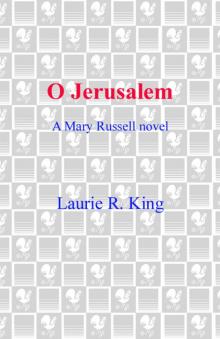 O Jerusalem
O Jerusalem Beekeeping for Beginners
Beekeeping for Beginners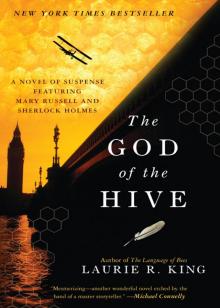 The God of the Hive
The God of the Hive The Language of Bees
The Language of Bees Night Work
Night Work Justice Hall
Justice Hall The Murder of Mary Russell
The Murder of Mary Russell Lockdown
Lockdown To Play the Fool
To Play the Fool Locked Rooms
Locked Rooms Island of the Mad
Island of the Mad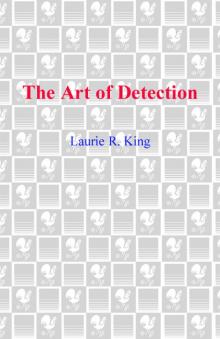 The Art of Detection
The Art of Detection The Mary Russell Series Books 1-4
The Mary Russell Series Books 1-4 The Beekeeper's Apprentice
The Beekeeper's Apprentice For the Sake of the Game
For the Sake of the Game A Darker Place
A Darker Place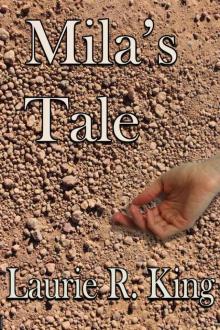 Mila's Tale
Mila's Tale Mrs Hudson's Case
Mrs Hudson's Case With Child
With Child The Marriage of Mary Russell
The Marriage of Mary Russell The Mary Russell Companion
The Mary Russell Companion Hellbender
Hellbender Castle Shade
Castle Shade The Bones of Paris
The Bones of Paris Riviera Gold
Riviera Gold A Grave Talent
A Grave Talent Pirate King
Pirate King Dreaming Spies
Dreaming Spies Folly
Folly Touchstone
Touchstone The Game
The Game The Mary Russell Series Books 1-4: The Beekeeper's Apprentice; A Monstrous Regiment of Women; A Letter of Mary; The Moor
The Mary Russell Series Books 1-4: The Beekeeper's Apprentice; A Monstrous Regiment of Women; A Letter of Mary; The Moor The Moor mr-4
The Moor mr-4 The Birth of a new moon
The Birth of a new moon With Child km-3
With Child km-3 A Letter of Mary mr-3
A Letter of Mary mr-3 Justice Hall mr-6
Justice Hall mr-6 Pirate King: A novel of suspense featuring Mary Russell and Sherlock Holmes
Pirate King: A novel of suspense featuring Mary Russell and Sherlock Holmes Pirate King: A novel of suspense featuring Mary Russell and Sherlock Holmes mr-11
Pirate King: A novel of suspense featuring Mary Russell and Sherlock Holmes mr-11 Beekeeping for Beginners (Short Story)
Beekeeping for Beginners (Short Story)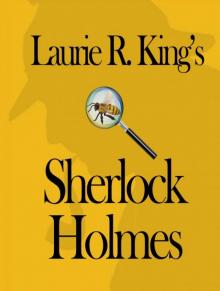 Laurie R. King's Sherlock Holmes
Laurie R. King's Sherlock Holmes Echoes of Sherlock Holmes
Echoes of Sherlock Holmes A Study in Sherlock
A Study in Sherlock The Game mr-7
The Game mr-7 Garment of Shadows: A Novel of Suspense Featuring Mary Russell and Sherlock Holmes
Garment of Shadows: A Novel of Suspense Featuring Mary Russell and Sherlock Holmes Dreaming Spies: A novel of suspense featuring Mary Russell and Sherlock Holmes
Dreaming Spies: A novel of suspense featuring Mary Russell and Sherlock Holmes Night Work km-4
Night Work km-4 Mary Russell's War
Mary Russell's War To Play the Fool km-2
To Play the Fool km-2 A Monstrous Regiment of Women mr-2
A Monstrous Regiment of Women mr-2 O Jerusalem mr-5
O Jerusalem mr-5 A Grave Talent km-1
A Grave Talent km-1